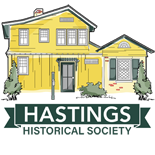Editor’s Note: This was the headline for an anonymous article that appeared in the Hastings News in July of 1929. Below is an edited version of the article. Though the first two photographs were taken by A.C. Langmuir when the streets were being widened in September and October of 1929, the scene must have been much the same as in July, when the telephone company installed the conduits that would be used to bury the network of wires that crisscrossed the sky above Hastings in the 1920s.
Warburton Avenue, looking south from the corner of Spring Street, October 4, 1929
All along Warburton Avenue, commuters, passers-by and little children with no baseball field to go to, are lingering over the piles of rock that are being dug up and piled up along the ditch in which the New York Telephone Company is placing conduits.
There was quite a crowd all this week at the corner of Spring Street and Warburton Avenue. The explosions caused by the blasting attracted many who were loath to leave, as shock after shock rocked the thoroughfare.
“Say! Look at that guy!” The crowd of boys looked. In the entrance of one of the row of vacant stores slept a worker. He not only slept. He snored. On his face was a look of beatific happiness. He was, any of the youngsters could see, at the height of bliss. “They ought to take that guy’s picture and give it to his boss.”
Warburton Avenue south of the bridge, looking south toward the corner of Washington Avenue, September 19, 1929
Then the whistle blew. With a start the worker awoke. His nimble wits sent him to his feet. When his foreman came around, he was first on his job.
“They ought to fire him and give me his job.
“They ought to put him in the Lyceum outfield!”
“Yeah! The Lyceums are good. They played some game last Sunday, I’m telling you.”
“Say, you saw the game with the Independents last Sunday, didn’t you? Well, did you notice that fellow, Wasko, who was pinch-hit in the last inning? I think it was the last. What a uniform he wore! He had a grey and red suit, green and white sleeves, a black hat, and purple and orange stockings.”
St. Matthew’s Lyceum on lower Warburton was a social organization for men and boys, organized in 1920. This photograph of the club’s baseball team shows both Sid Limekiller (seated third from the right) and John Vasko (aka Wasko, standing second from the right).
“And did you see Sid Limekiller forget where he put his glove when he went out to pitch that same inning? He couldn’t find it, and the rest of the boys were on the field. Finally they got hold of it, nestling behind second.”
Several of the men standing before the Farragut Inn laughed. “Funny how the kids notice those things,” he said. “By the way, did you see the mayor there last Sunday?”
His companion replied that he had not, and the two fell into a discussion as to what would happen if the mayor [Thomas F. Reyolds], the acting mayor, [Henry D.] Cochrane, and the acting mayor’s alternate, James Magee, all were gone. …
Thomas F. Reynolds (second from the right) at a St. Matthew’s Lyceum game. Mayor Reynolds acquired the uniforms for the team from New York Yankees owner Col. Jacob Ruppert. The photograph shows, left to right, umpire H. Shaefer, William Steinschneider, Fred H. Charles, Reynolds, and umpire Louis Limekiller.
Two men, waiting for the blasting foreman to let them through on their way down Warburton Avenue to Dobbs Ferry, were discussing a sermon recently made by Father Southwick, curate of the Sacred Heart Church, of Dobbs Ferry. …
Two other men took their places, idling on the corner, watching the diggers and waiting for the next blast. They fell to talking about the movie that the Reo Company had recently made in Dobbs Ferry. Their discussion attracted another bystander. “Those auto wrecks that they put on were the real thing,” he said. “Why I wouldn’t have done it for – well, it would have taken a whole lot o money, believe me.” …
And that’s what men talk about when they’re watching other men dig a ditch.













